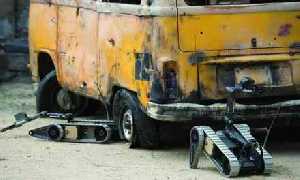Articles >>
U.S. Army building smarter robots
Category: Army

WASHINGTON -- The U.S. Army is exploring ways to upgrade its fleet of roughly 3,000 small tactical robots in Iraq and Afghanistan designed to safeguard Soldiers by clearing buildings and caves and using sensors to sweep areas for Improvised Explosive Devices, service officials said. New technologies bring the promise of deploying small robots which can search for bombs, map areas and detect hazardous materials -- all with little or no tele-operation or human intervention. "We are moving along that spectrum from tele-operating to semi-autonomy where you can send a robot from point A to point B without any intervention. If it has a problem, it will pop up and indicate it has found an obstacle," said U.S. Marine Corps Lt. Col. David Thompson, project manager with the Robotic Systems Joint Program Office. The Army and Marine Corps are working with industry and academic partners to look at ways to add new software to existing robots -- such as iRobot's PackBot and Qinetic North America's TALON -- enabling them to perform more functions and navigate uncertain terrain without needing their every move to be controlled or tele-operated by a human. "We are looking at ways to make the systems that we already have out there better. We are working with infantry and the (Military Police) to look at how we can enhance the capabilities of our current robots to meet their needs," said Thompson. Some of the newer robotic capabilities, such as automatic self-righting and retro-traversing, enable robots to correct course, change direction or turn right-side up -- by themselves. "We're looking for modularity and interoperability. It will take the burden off the user. I want a robot to go from point A to point B by itself, and tell me when it gets there," Thompson said. "We're going to get better interface with the cameras and the grippers -- and a lot more understanding of where the robot sits in space." A more autonomous robot allows the user to free up energy which would otherwise be focused purely on navigating the robot. This will allow the user to attend to additional concerns, robotic functions or threats. "We want to be able to allow Soldiers to interact with the robots at a high level of supervisory input to the robots. To do that, the robot has to start understanding where it is, start understanding about what is in the way, and how to get around obstacles," said Colin Angle, chairman and chief executive officer, iRobot. For instance, iRobot's AwareHead supervisory control system software enables semi-autonomous navigation; the robot uses infrared sensors to map an area by itself, allowing a human controller to point-and-click on a touch-screen to send the robot to a given destination. "When we started, we had one robot and one controller, now you have much more operational and logistical flexibility. The exciting part is we're right at the cusp of much, much smarter robots. Yesterday's robots were head down, one guy controlling the robot every step of the way. Now, we are talking about robots that can do much more for themselves," said Joseph Dyer, chief operating officer, iRobot. QinetiQ North America is also working with the Army and Marine Corps to advance robotics technology; at Fort Benning, Ga., their TALON Explosive Ordnance Disposal robot recently demonstrated an ability to navigate and map a room without human intervention, company officials said. "We demonstrated a completely autonomous TALON robot with chemical, biological and radiological detection abilities. A map was created about 1,000 meters away from the building showing what was inside a building and where the hazards were -- the robot was able to do that without any tele-operation," said Robert Quinn, vice president, TALON Operations, QinetiQ North America. "In Afghanistan, 80 percent of the IEDs are homemade explosives, so having the ability in 30 minutes or less to do a complete investigation of buildings and check for homemade explosives -- without Soldiers ever entering the building -- is awfully important," Quinn said. In order to maximize the occasion to learn from Soldiers in combat and harness their critical feedback, the Robotic Systems Joint Program Office has several facilities in Iraq and Afghanistan, Thompson said. "Feedback that we need from the warfighters is critical," he said. "You can send it out there where a man should not go in order to counter a threat and do the dull, dirty, or dangerous jobs," said Thompson. "I would rather have a robot blown up than a Soldier or Marine." |
U.S. Army |
QinetiQ and Pratt Miller Deliver First Robotic Combat Vehicle - Light to U.S. Army
02.02.2021
BAE Systems Teams with QinetiQ to Pursue Electric Drive on Combat Vehicles
04.06.2017
QNA Partners with Persistent Systems to Integrate MPU5 Radios into Family of UGV
12.01.2017
BAE Systems` Team Challenger® 2 awarded Assessment Phase for Life Extension Project
25.12.2016
TALON (Robot, Unmanned Vehicle)
Hafeet 640 Talon (Armoured car)
Discuss
